|
|
|
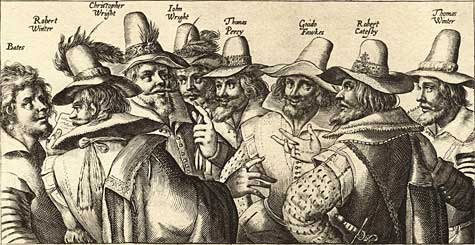

GUNPOWDER PLOT, the name given to a conspiracy for blowing up King James I and the parliament on the 5th of November 1605.
To understand clearly the nature and origin of the famous conspiracy, it is necessary to recall the political situation and the attitude of the Roman Catholics towards the government at the accession of James I. The Elizabethan administration had successfully defended its own existence and the Protestant faith against able and powerful antagonists, but this had not been accomplished without enforcing severe measures of repression and punishment upon those of the opposite faith.
The beginning of a happier era, however, was expected with the opening of the new reign. The right of James to the crown could be more readily acknowledged by the Romanists than that of Elizabeth: Pope Clement VIII appeared willing to meet the king half-way. James himself was by nature favourable to the Roman Catholics and had treated the Roman Catholic lords in Scotland with great leniency, in spite of their constant plots and rebellions. Writing to Cecil before his accession he maintained, "I am so far from any intention of persecution as I protest to God I reverence their church as our mother church, although clogged with many infirmities and corruptions, besides that I did ever hold persecution as one of the infallible notes of a false church." He declared to Northumberland, the kinsman and master of Thomas Percy, the conspirator, "as for the Catholics, I will neither persecute any that will be quiet and give but an outward obedience to the law, neither will I spare to advance any of them that will be of good service and worthily deserved."
It is probable that these small but practical concessions would have satisfied the lay Roman Catholics and the secular priests, but they were very far from contenting the Jesuits, by whom the results of such leniency were especially feared: "What rigour of laws would not compass in so many years," wrote Henry Tichborne, the Jesuit, in 1598, "this liberty and lenity will effectuate in 20 days, to wit the disfurnishing of the seminaries, the disanimating of men to come and others to return, the expulsion of the society and confusion as in Germany, extinction of zeal and favour, disanimation of princes from the hot pursuit of the enterprise.... We shall be left as a prey to the wolves that will besides drive our greatest patron [the king of Spain] to stoop to a peace which will be the utter ruin of our edifice, this many years in building." Unfortunately, about this time the Jesuits, who thus thrived on political intrigue, and who were deeply implicated in treasonable correspondence with Spain, had obtained a complete ascendancy over the secular priests, who were for obeying the civil government as far as possible and keeping free from politics. The time, therefore, as far as the Roman Catholics themselves were concerned, was not a propitious one for introducing the moderate concessions which alone James had promised.
James, too, on his side, found that religious toleration, though clearly sound in principle, was difficult in practice. During the first few months of the reign all went well. In July 1603 the fines for recusancy were remitted. In January 1604 peaceable Roman Catholics could live unmolested and "serve God according to their consciences without any danger." But James's expectations that the pope would prevent dangerous and seditious persons from entering the country were unfulfilled and the numbers of the Jesuits and the Roman Catholics greatly increased. Rumours of plots came to hand. Cecil, though like his master naturally in favour of toleration, with his experience gained in the reign of Elizabeth, was alarmed at the policy pursued and its results, and great anxiety was aroused in the government and nation, which was in the end shared by the king. It was determined finally to return to the earlier policy of repression. On the 22nd of February 1604 a proclamation was issued banishing priests; on the 28th of November 1604, recusancy fines were demanded from 13 wealthy persons, and on the 10th of February 1605 the penal laws were ordered to be executed.
The plot, however, could not have been occasioned by these measures, for it had been already conceived in the mind of Robert Catesby. It was aimed at the repeal of the whole Elizabethan legislation against the Roman Catholics and perhaps derived some impulse at first from the leniency lately shown by the administration, afterwards gaining support from the opposite cause, the return of the government to the policy of repression.
It was in May 1603 that Catesby told Percy, in reply to the latter's declaration of his intention to kill the king, that he was "thinking of a most sure way." Subsequently, about the 1st of November 1603, Catesby sent a message to his cousin Robert Winter at Huddington, near Worcester, to come to London, which the latter refused. On the arrival of a second urgent summons shortly afterwards he obeyed, and was then at a house at Lambeth, probably in January 1604, initiated by Catesby together with John Wright into the plot to blow up the parliament house. Before putting this plan into execution, however, it was decided to try a "quiet way "; and Winter was sent over to Flanders to obtain the good offices of Juan de Velasco, duke of Frias and constable of Castile, who had arrived there to conduct the negotiations for a peace between England and Spain, in order to obtain the repeal of the penal laws.
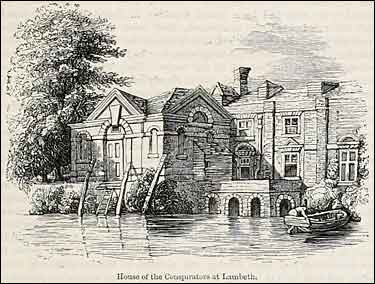
Winter, having secured nothing but vain promises from the constable, returned to England about the end of April, bringing with him Guy Fawkes, a man devoted to the Roman Catholic cause and recommended for undertaking perilous adventures. Subsequently the three and Thomas Percy, who joined the conspiracy in May, met in a house behind St Clement's and, having taken an oath of secrecy together, heard Mass and received the Sacrament in an adjoining apartment from a priest staled by Fawkes to have been Father Gerard. Later several other persons were included in the plot, viz. Winter's brother Thomas, John Grant, Ambrose Rokewood, Robert Keyes, Sir Everard Digby, Francis Tresham, a cousin of Thresh and Thomas Bates Catesby's servant, all, with the exception of the last, being men of good family and all Roman Catholics. Father Greenway and Father Garnet, the Jesuits, were both cognisant of the plot.
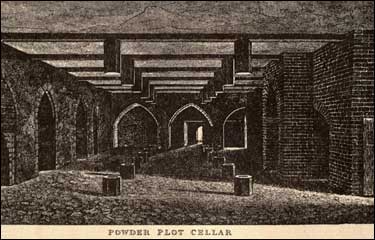
On the 24th of May 1604 a house was hired in Percy's name adjoining the House of Lords, from the cellar of which they proposed to work a mine. They began on the 11th of December 1604, and by about March had got half-way through the wall. They then discovered that a vault immediately under the House of Lords was available. This was at once hired by Percy, and 36 barrels of gunpowder, amounting to about 1 ton and 12 cwt., were brought in and concealed under coal and faggots. The preparations being completed in May the conspirators separated. Fawkes was despatched to Flanders, where he imparted the plot to Hugh Owen, a zealous Romanist intriguer. Sir Edmund Baynham was sent on a mission to Rome to be at hand when the news came to gain over the pope to the cause of the successful conspirators. An understanding was arrived at with several officers levied for the service of the archduke, that they should return at once to England when occasion arose of defending the Roman Catholic cause.
A great hunting match was organized at Danchurch in Warwickshire by Digby, to which large numbers of the Roman Catholic gentry were invited, who were to join the plot after the successful accomplishment of the explosion of the 5th of November, the day fixed for the opening of parliament, and get possession of the princess Elizabeth, then residing in the neighbourhood; while Percy was to seize the infant prince Charles and bring him on horseback to their meeting-place. Guy Fawkes himself was to take ship immediately for Flanders, spread the news on the continent and get supporters. The conspirators imagined that a terrorized and helpless government would readily agree to all their demands. Hitherto the secret had been well kept and the preparations had been completed with extraordinary success and without a single drawback; but a very serious difficulty now confronted the conspirators as the time for action arrived, and disturbed their consciences. The feelings of ordinary humanity shrunk from the destruction of so many persons guiltless of any offence. But in addition, among the peers to be assassinated were included many Roman Catholics and some lords nearly connected in kinship or friendship with the plotters themselves. Several appeals, however, made to Catesby to allow warning to be given to certain individuals were firmly rejected.
On the 26th of October Lord Monteagle, a brother-in-law of Francis Tresham, who had formerly been closely connected with some of the other conspirators and had engaged in Romanist plots against the government, but who had given his support to the new king, unexpectedly ordered supper to be prepared at his house at Haxton, from which he had been absent for more than a year. While at supper about 6 o'clock an anonymous letter was brought by an unknown messenger which, having glanced at, he handed to Ward, a gentleman of his service and an intimate friend of Winter, the conspirator, to be read aloud. The celebrated letter ran as follows:—
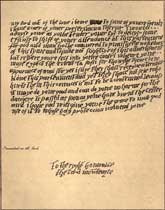 "My lord, out of the love I bear to some of your friends, I have a care for your preservation. Therefore I would advise you, as you tender your life, to devise some excuse to shift of your attendance of this Parliament, for God and man hath concurred to punish the wickedness of this time. And think not slightly of this advertisement, but retire yourself into your country, where you may expert the event in safety, for though there be no appearance of any stir, yet I say they shall receive a terrible blow the Parliament, an yet they shall not see who hurts them. This counsel is not to be contemned, because it may do you good and can do you no harm for the danger is past as soon as you have burnt the letter: and I hope God will give you the Grace to make good use of it, to whose holy protection I commend you."
"My lord, out of the love I bear to some of your friends, I have a care for your preservation. Therefore I would advise you, as you tender your life, to devise some excuse to shift of your attendance of this Parliament, for God and man hath concurred to punish the wickedness of this time. And think not slightly of this advertisement, but retire yourself into your country, where you may expert the event in safety, for though there be no appearance of any stir, yet I say they shall receive a terrible blow the Parliament, an yet they shall not see who hurts them. This counsel is not to be contemned, because it may do you good and can do you no harm for the danger is past as soon as you have burnt the letter: and I hope God will give you the Grace to make good use of it, to whose holy protection I commend you."
The authorship of the letter has never been disclosed or proved, but all evidence seems to point to Tresham, and to the probability that he had some days before warned Monteagle and agreed with him as to the best means of making known the plot and preventing its execution, and at the same time of giving the conspirators time to escape.
Monteagle at once started for Whitehall, found Salisbury and other ministers about to sit down to supper, and showed the letter, whereupon it was decided to search the cellar under the House of Lords before the meeting of parliament, but not too soon, so that the plot might be ripe, and be fully disclosed. Meanwhile Ward, on the 27th of October, as had evidently been intended, informed Winter that the plot was known, and on the 28th Winter informed Catesby and begged him to give up the whole project. Catesby, however, after some hesitation, finding from Fawkes that nothing had been touched in the cellar, and prevailed upon by Percy, determined to stand firm, hoping that the government had put no credence in Monteagle's letter, and Fawkes returned to the cellar to keep guard as before. On the 4th the king, having been shown the letter, ordered the earl of Suffolk, as lord chamberlain, to examine the buildings. He was accompanied by Monteagle. On arriving at the cellar, the door was opened to him by Fawkes. Seeing the enormous piles of faggots he asked the name of their owner, to which Fawkes replied that they belonged to Percy. His name immediately aroused suspicions, and accordingly it was ordered that a further search should be made by Thomas Knyvett, a Westminster magistrate who, coming with his men at night, discovered the gunpowder and arrested Fawkes on the threshold.
The opinion that the whole plot was the work of Salisbury, that he acted as an agent provocateur and lured on his victims to destruction, repeated by some contemporary and
later writers and recently formulated and urged with great ability, has no solid foundation. Nor is it even probable that he was aware of its existence till he received Monteagle's
letter. Even after its reception complete belief was not placed in the warning. A search was made only to make sure that nothing was wrong and guided only by Monteagle's letter,
while no attempt was made to seize the conspirators. The steps taken by Salisbury after the discovery of the gunpowder do not show the possession of any information of the plot or
of the persons who were its chief agents outside Fawkes's first statement, and his knowledge is seen to develop according to the successive disclosures and confessions of the latter.
Thus on the 7th of November he had no knowledge of the mine, and it is only after Fawkes's examination by torture on the 9th, when the names of the conspirators were drawn
from him, that the government was able to classify them according to their guilt and extent of their participation.
The inquiry was not conducted by Salisbury alone, but by several commissioners, some of whom were Roman Catholics, and many rivals and secret enemies. To conceal his intrigue from
all these would have been impossible, and that he should have put himself in their power to such an extent is highly improbable. Again, the plan agreed upon for disclosing the plot was especially designed to allow the conspirators to escape, and therefore scarcely a method which would have been arranged with Salisbury. Not one of the conspirators, even when all hope of saving life was gone, made any accusation against Salisbury or the government and all died expressing contrition for their crime. Lastly Salisbury had no conceivable motive in concocting a plot of this description. His political power and position in the new reign had been already secured and by very different methods. He was now at the height of his influence, having been created Viscount Cranborne in August 1604 and earl of Salisbury in May 1605; and James had already, more than 16 months before the discovery of the plot, consented to return to the repressive measures against the Romanists. The success with which the conspirators concealed their plot from Salisbury's spies is indeed astonishing, but is probably explained by its very audacity and by the absence of incriminating correspondence, the medium through which the minister chiefly obtained his knowledge of the plans of his enemies.
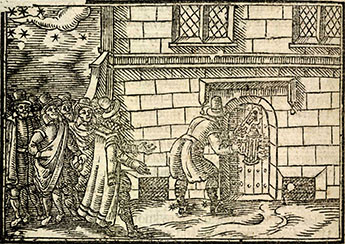
On the arrest of Fawkes the other conspirators, except Tresham, fled in parties by different ways, rejoining each other in Warwickshire, as had been agreed in case the plot had been successful. Catesby, who with some others had covered the distance of 80 mi. between London and his mother's house at Ashby St Legers in eight hours, informed his friends in Warwickshire, who had been awaiting the issue of the plot, of its failure, but succeeded in persuading Sir Everard Digby, by an unscrupulous falsehood, to further implicate himself in his hopeless cause by assuring him that both James and Salisbury were dead; and, according to Father Garnet, this was not the first time that Catesby had been guilty of lies in order to draw men into the plot. He pushed on the same day with his companions in the direction of Wales, where, it was hoped, they would be joined by bands of insurgents. They arrived at Huddington at 2 in the afternoon. On the morning of the 7th the band, numbering about 36 persons, confessed and heard Mass, and then rode away to Holbeche, 2 mi. from Stourbridge, in Staffordshire, the house of Stephen Littleton, who had been present at the hunting at Danchurch, where they arrived at 10 o'clock at night, having on their way broken into Lord Windsor's house at Hewell Grange and taken all the armour they found there.
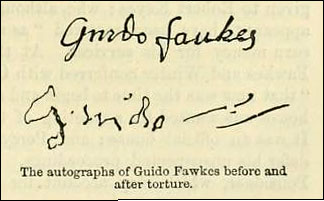
Their case was now desperate. None had joined them: "Not one came to take our part," said Sir Everard Digby, "though we had expected so many." They were being followed by the sheriff and all the forces of the county. All spurned them from their doors when they applied for succour. One by one their followers fled from the house in which the last scene was to be played out. They now began to feel themselves abandoned not only by man but by God; for an explosion of some of their gunpowder, on the morning of the 8th, by which Catesby and some others were scorched, struck terror into their hearts as a judgment from heaven. The assurance of innocence and of a just cause which till now had alone supported them was taken away. The greatness of their crime, its true nature, now struck home to them, and the few moments which remained to them of life were spent in prayer and in repentance. The supreme hour had now arrived. About 11 o'clock the sheriff and his men came up and immediately began firing into the house. Catesby, Percy and the two Wrights were killed, Winter and Rokewood wounded and taken prisoners with the men who still adhered to them. In all eight of the conspirators, including the two Winters, Digby, Fawkes, Rokewood, Keyes and Bates, were executed, while Tresham died in the Tower. Of the priests involved, Garnet was tried and executed, while Greenway and Gerard succeeded in escaping.
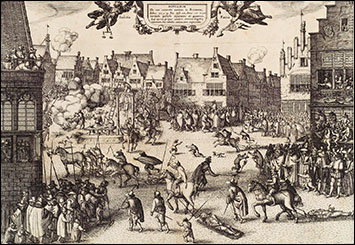
So ended the strange and famous Gunpowder Plot. However atrocious its conception and its aims, it is impossible not to feel, together with horror for the deed,
some pity and admiration for the guilty persons who took part in it. "Theirs was a crime which it would never have entered into the heart of any man to commit who was not raised
above the lowness of the ordinary criminal." They sinned not against the light but in the dark. They erred from ignorance, from a perverted moral sense rather than from any mean
or selfish motive, and exhibited extraordinary courage and self-sacrifice in the pursuit of what seemed to them the cause of God and of their country.
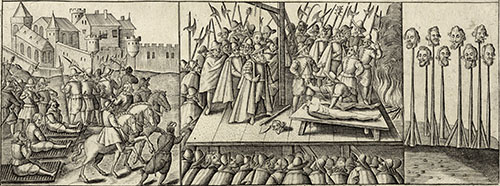
Their punishment was terrible. Not only had they risked and lost all in the attempt and drawn upon themselves the frightful vengeance of the state, but they saw themselves the means of injuring irretrievably the cause for which they felt such devotion. Nothing could have been more disastrous to the cause of the Roman Catholics than their crime. The laws against them were immediately increased in severity, and the gradual advance towards religious toleration was put back for centuries. In addition a new, increased and long-enduring hostility was aroused in the country against the adherents of the old faith, not unnatural in the circumstances, but unjust and undiscriminating, because while some of the Jesuits were no doubt implicated, the secular priests and Roman Catholic laity as a whole had taken no part in the conspiracy.
Excerpted from:
The Encyclopædia Britannica, 11th Ed. Vol XII.
New York: The Encyclopædia Britannica Company, 1910. 727-9.
Other Local Resources:
Books for further study:
Beardsley, Martyn R. The Gunpowder Plot Deceit.
Philadelphia: Pen and Sword Books, 2019.
Fraser, Antonia. Faith and Treason: The Story of the Gunpowder Plot.
New York: Anchor Books, 1997.
Hogge, Alice. God's Secret Agents: Queen Elizabeth's Forbidden Priests
and the Hatching of the Gunpowder Plot.
New York: Harper Perennial, 2006.
Travers, James. Gunpowder: The Players Behind the Plot
Kew, Richmond, Surrey: The National Archives, 2005.
The Gunpowder Plot on the Web:
 | to King James I |
 | to Luminarium Encyclopedia |
Site copyright ©1996-2023 Anniina Jokinen. All Rights Reserved.
Created by Anniina Jokinen on November 5, 2010. Last updated February 6, 2023.
|
Index of Encyclopedia Entries:
Medieval Cosmology
Prices of Items in Medieval England
Edward II
Isabella of France, Queen of England
Piers Gaveston
Thomas of Brotherton, E. of Norfolk
Edmund of Woodstock, E. of Kent
Thomas, Earl of Lancaster
Henry of Lancaster, Earl of Lancaster
Henry of Grosmont, Duke of Lancaster
Roger Mortimer, Earl of March
Hugh le Despenser the Younger
Bartholomew, Lord Burghersh, elder
Hundred Years' War (1337-1453)
Edward III
Philippa of Hainault, Queen of England
Edward, Black Prince of Wales
John of Eltham, Earl of Cornwall
The Battle of Crécy, 1346
The Siege of Calais, 1346-7
The Battle of Poitiers, 1356
Lionel of Antwerp, Duke of Clarence
John of Gaunt, Duke of Lancaster
Edmund of Langley, Duke of York
Thomas of Woodstock, Gloucester
Richard of York, E. of Cambridge
Richard Fitzalan, 3. Earl of Arundel
Roger Mortimer, 2nd Earl of March
The Good Parliament, 1376
Richard II
The Peasants' Revolt, 1381
Lords Appellant, 1388
Richard Fitzalan, 4. Earl of Arundel
Archbishop Thomas Arundel
Thomas de Beauchamp, E. Warwick
Robert de Vere, Earl of Oxford
Ralph Neville, E. of Westmorland
Thomas Mowbray, Duke of Norfolk
Edmund Mortimer, 3. Earl of March
Roger Mortimer, 4. Earl of March
John Holland, Duke of Exeter
Michael de la Pole, E. Suffolk
Hugh de Stafford, 2. E. Stafford
Henry IV
Edward, Duke of York
Edmund Mortimer, 5. Earl of March
Henry Percy, Earl of Northumberland
Sir Henry Percy, "Harry Hotspur"
Thomas Percy, Earl of Worcester
Owen Glendower
The Battle of Shrewsbury, 1403
Archbishop Richard Scrope
Thomas Mowbray, 3. E. Nottingham
John Mowbray, 2. Duke of Norfolk
Thomas Fitzalan, 5. Earl of Arundel
Henry V
Thomas, Duke of Clarence
John, Duke of Bedford
Humphrey, Duke of Gloucester
John Talbot, Earl of Shrewsbury
Richard, Earl of Cambridge
Henry, Baron Scrope of Masham
William de la Pole, Duke of Suffolk
Thomas Montacute, E. Salisbury
Richard Beauchamp, E. of Warwick
Henry Beauchamp, Duke of Warwick
Thomas Beaufort, Duke of Exeter
Cardinal Henry Beaufort
John Beaufort, Earl of Somerset
Sir John Fastolf
John Holland, 2. Duke of Exeter
Archbishop John Stafford
Archbishop John Kemp
Catherine of Valois
Owen Tudor
John Fitzalan, 7. Earl of Arundel
John, Lord Tiptoft
Charles VII, King of France
Joan of Arc
Louis XI, King of France
Charles the Bold, Duke of Burgundy
The Battle of Agincourt, 1415
The Battle of Castillon, 1453
The Wars of the Roses 1455-1485
Causes of the Wars of the Roses
The House of Lancaster
The House of York
The House of Beaufort
The House of Neville
The First Battle of St. Albans, 1455
The Battle of Blore Heath, 1459
The Rout of Ludford, 1459
The Battle of Northampton, 1460
The Battle of Wakefield, 1460
The Battle of Mortimer's Cross, 1461
The 2nd Battle of St. Albans, 1461
The Battle of Towton, 1461
The Battle of Hedgeley Moor, 1464
The Battle of Hexham, 1464
The Battle of Edgecote, 1469
The Battle of Losecoat Field, 1470
The Battle of Barnet, 1471
The Battle of Tewkesbury, 1471
The Treaty of Pecquigny, 1475
The Battle of Bosworth Field, 1485
The Battle of Stoke Field, 1487
Henry VI
Margaret of Anjou
Richard Plantagenet, Duke of York
Edward IV
Elizabeth Woodville
Richard Woodville, 1. Earl Rivers
Anthony Woodville, 2. Earl Rivers
Jane Shore
Edward V
Richard III
George, Duke of Clarence
Ralph Neville, 2. Earl of Westmorland
Richard Neville, Earl of Salisbury
Richard Neville, Earl of Warwick
Edward Neville, Baron Bergavenny
William Neville, Lord Fauconberg
Robert Neville, Bishop of Salisbury
John Neville, Marquis of Montagu
George Neville, Archbishop of York
John Beaufort, 1. Duke Somerset
Edmund Beaufort, 2. Duke Somerset
Henry Beaufort, 3. Duke of Somerset
Edmund Beaufort, 4. Duke Somerset
Margaret Beaufort
Edmund Tudor, Earl of Richmond
Jasper Tudor, Earl of Pembroke
Humphrey Stafford, D. Buckingham
Henry Stafford, Duke of Buckingham
Humphrey Stafford, E. of Devon
Thomas, Lord Stanley, Earl of Derby
Sir William Stanley
Archbishop Thomas Bourchier
Henry Bourchier, Earl of Essex
John Mowbray, 3. Duke of Norfolk
John Mowbray, 4. Duke of Norfolk
John Howard, Duke of Norfolk
Henry Percy, 2. E. Northumberland
Henry Percy, 3. E. Northumberland
Henry Percy, 4. E. Northumberland
William, Lord Hastings
Henry Holland, Duke of Exeter
William Fitzalan, Earl of Arundel
William Herbert, 1. Earl of Pembroke
John de Vere, 12th Earl of Oxford
John de Vere, 13th Earl of Oxford
Thomas de Clifford, 8. Baron Clifford
John de Clifford, 9. Baron Clifford
John Tiptoft, Earl of Worcester
Thomas Grey, 1. Marquis Dorset
Sir Andrew Trollop
Archbishop John Morton
Edward Plantagenet, E. of Warwick
John Talbot, 2. E. Shrewsbury
John Talbot, 3. E. Shrewsbury
John de la Pole, 2. Duke of Suffolk
John de la Pole, E. of Lincoln
Edmund de la Pole, E. of Suffolk
Richard de la Pole
John Sutton, Baron Dudley
James Butler, 5. Earl of Ormonde
Sir James Tyrell
Edmund Grey, first Earl of Kent
George Grey, 2nd Earl of Kent
John, 5th Baron Scrope of Bolton
James Touchet, 7th Baron Audley
Walter Blount, Lord Mountjoy
Robert Hungerford, Lord Moleyns
Thomas, Lord Scales
John, Lord Lovel and Holand
Francis Lovell, Viscount Lovell
Sir Richard Ratcliffe
William Catesby
Ralph, 4th Lord Cromwell
Jack Cade's Rebellion, 1450
Tudor Period
King Henry VII
Queen Elizabeth of York
Arthur, Prince of Wales
Lambert Simnel
Perkin Warbeck
The Battle of Blackheath, 1497
King Ferdinand II of Aragon
Queen Isabella of Castile
Maximilian I, Holy Roman Emperor
King Henry VIII
Queen Catherine of Aragon
Queen Anne Boleyn
Queen Jane Seymour
Queen Anne of Cleves
Queen Catherine Howard
Queen Katherine Parr
King Edward VI
Queen Mary I
Queen Elizabeth I
Henry Fitzroy, Duke of Richmond
Margaret Tudor, Queen of Scotland
James IV, King of Scotland
The Battle of Flodden Field, 1513
James V, King of Scotland
Mary of Guise, Queen of Scotland
Mary Tudor, Queen of France
Louis XII, King of France
Francis I, King of France
The Battle of the Spurs, 1513
Field of the Cloth of Gold, 1520
Charles V, Holy Roman Emperor
Eustace Chapuys, Imperial Ambassador
The Siege of Boulogne, 1544
Cardinal Thomas Wolsey
Archbishop Thomas Cranmer
Thomas Cromwell, Earl of Essex
Thomas, Lord Audley
Thomas Wriothesley, E. Southampton
Sir Richard Rich
Edward Stafford, D. of Buckingham
Thomas Howard, 2nd Duke of Norfolk
Thomas Howard, 3rd Duke of Norfolk
John Dudley, Duke of Northumberland
Charles Brandon, Duke of Suffolk
Thomas Boleyn, Earl of Wiltshire
George Boleyn, Viscount Rochford
John Russell, Earl of Bedford
Thomas Grey, 2. Marquis of Dorset
Henry Grey, D. of Suffolk
Charles Somerset, Earl of Worcester
George Talbot, 4. E. Shrewsbury
Francis Talbot, 5. E. Shrewsbury
Henry Algernon Percy,
5th Earl of Northumberland
Henry Algernon Percy,
6th Earl of Northumberland
Ralph Neville, 4. E. Westmorland
Henry Neville, 5. E. Westmorland
William Paulet, Marquis of Winchester
Sir Francis Bryan
Sir Nicholas Carew
John de Vere, 15th Earl of Oxford
John de Vere, 16th Earl of Oxford
Thomas Seymour, Lord Admiral
Edward Seymour, Protector Somerset
Margaret Pole, Countess of Salisbury
Henry Pole, Lord Montague
Sir Geoffrey Pole
Thomas Manners, Earl of Rutland
Henry Manners, Earl of Rutland
Henry Bourchier, 2. Earl of Essex
Robert Radcliffe, 1. Earl of Sussex
Henry Radcliffe, 2. Earl of Sussex
George Hastings, Earl of Huntingdon
Henry Courtenay, Marquis of Exeter
George Neville, Baron Bergavenny
Sir Edward Neville
William, Lord Paget
William Sandys, Baron Sandys
William Fitzwilliam, E. Southampton
Sir Anthony Browne
Sir Thomas Wriothesley
Sir William Kingston
George Brooke, Lord Cobham
Sir Richard Southwell
Thomas Fiennes, 9th Lord Dacre
Sir Francis Weston
Henry Norris
Lady Jane Grey
Sir Thomas Arundel
Sir Richard Sackville
Sir William Petre
Sir John Cheke
Walter Haddon, L.L.D
Sir Peter Carew
Sir John Mason
Nicholas Wotton
John Taylor
Sir Thomas Wyatt, the Younger
Cardinal Lorenzo Campeggio
Cardinal Reginald Pole
Stephen Gardiner, Bishop of Winchester
Edmund Bonner, Bishop of London
Nicholas Ridley, Bishop of London
John Hooper, Bishop of Gloucester
John Aylmer, Bishop of London
Thomas Linacre
William Grocyn
Archbishop William Warham
Cuthbert Tunstall, Bishop of Durham
Richard Fox, Bishop of Winchester
Edward Fox, Bishop of Hereford
Pope Julius II
Pope Leo X
Pope Clement VII
Pope Paul III
Pope Pius V
Pico della Mirandola
Desiderius Erasmus
Martin Bucer
Richard Pace
Christopher Saint-German
Thomas Tallis
Elizabeth Barton, the Nun of Kent
Hans Holbein, the Younger
The Sweating Sickness
Dissolution of the Monasteries
Pilgrimage of Grace, 1536
Robert Aske
Anne Askew
Lord Thomas Darcy
Sir Robert Constable
Oath of Supremacy
The Act of Supremacy, 1534
The First Act of Succession, 1534
The Third Act of Succession, 1544
The Ten Articles, 1536
The Six Articles, 1539
The Second Statute of Repeal, 1555
The Act of Supremacy, 1559
Articles Touching Preachers, 1583
Queen Elizabeth I
William Cecil, Lord Burghley
Robert Cecil, 1st Earl of Salisbury
Sir Francis Walsingham
Sir Nicholas Bacon
Sir Thomas Bromley
Robert Dudley, Earl of Leicester
Ambrose Dudley, Earl of Warwick
Henry Carey, Lord Hunsdon
Sir Thomas Egerton, Viscount Brackley
Sir Francis Knollys
Katherine "Kat" Ashley
Lettice Knollys, Countess of Leicester
George Talbot, 6. E. of Shrewsbury
Elizabeth, Countess of Shrewsbury
Gilbert Talbot, 7. E. of Shrewsbury
Sir Henry Sidney
Sir Robert Sidney
Archbishop Matthew Parker
Walter Devereux, 1st Earl of Essex
Robert Devereux, 2nd Earl of Essex
Penelope Devereux, Lady Rich
Sir Christopher Hatton
Edward Courtenay, E. Devonshire
Edward Manners, 3rd Earl of Rutland
Thomas Radcliffe, 3. Earl of Sussex
Henry Radcliffe, 4. Earl of Sussex
Robert Radcliffe, 5. Earl of Sussex
William Parr, Marquis of Northampton
Henry Wriothesley, 2. Southampton
Henry Wriothesley, 3. Southampton
Charles Neville, 6. E. Westmorland
Thomas Percy, 7. E. Northumberland
Henry Percy, 8. E. Northumberland
Henry Percy, 9. E. Nothumberland
William Herbert, 1. Earl of Pembroke
Charles, Lord Howard of Effingham
Thomas Howard, 4th Duke of Norfolk
Henry Howard, 1. Earl of Northampton
Thomas Howard, 1. Earl of Suffolk
Henry Hastings, 3. E. of Huntingdon
Edward Manners, 3rd Earl of Rutland
Roger Manners, 5th Earl of Rutland
Francis Manners, 6th Earl of Rutland
Henry FitzAlan, 12. Earl of Arundel
Thomas, Earl Arundell of Wardour
Edward Somerset, E. of Worcester
William Davison
Sir Walter Mildmay
Sir Ralph Sadler
Sir Amyas Paulet
Gilbert Gifford
Anthony Browne, Viscount Montague
François, Duke of Alençon & Anjou
Mary, Queen of Scots
Henry Stuart, Lord Darnley
James Hepburn, Earl of Bothwell
Anthony Babington and the Babington Plot
John Knox
Philip II of Spain
The Spanish Armada, 1588
Sir Francis Drake
Sir John Hawkins
William Camden
Archbishop Whitgift
Martin Marprelate Controversy
John Penry (Martin Marprelate)
Richard Bancroft, Archbishop of Canterbury
John Dee, Alchemist
Philip Henslowe
Edward Alleyn
The Blackfriars Theatre
The Fortune Theatre
The Rose Theatre
The Swan Theatre
Children's Companies
The Admiral's Men
The Lord Chamberlain's Men
Citizen Comedy
The Isle of Dogs, 1597
Common Law
Court of Common Pleas
Court of King's Bench
Court of Star Chamber
Council of the North
Fleet Prison
Assize
Attainder
First Fruits & Tenths
Livery and Maintenance
Oyer and terminer
Praemunire
The Stuarts
King James I of England
Anne of Denmark
Henry, Prince of Wales
The Gunpowder Plot, 1605
George Villiers, 1st Duke of Buckingham
Robert Carr, Earl of Somerset
Arabella Stuart, Lady Lennox
William Alabaster
Bishop Hall
Bishop Thomas Morton
Archbishop William Laud
John Selden
Lucy Harington, Countess of Bedford
Henry Lawes
King Charles I
Queen Henrietta Maria
Long Parliament
Rump Parliament
Kentish Petition, 1642
Thomas Wentworth, Earl of Strafford
John Digby, Earl of Bristol
George Digby, 2nd Earl of Bristol
Thomas Fairfax, 3rd Lord Fairfax
Robert Devereux, 3rd E. of Essex
Robert Sidney, 2. E. of Leicester
Algernon Percy, E. of Northumberland
Henry Montagu, Earl of Manchester
Edward Montagu, 2. Earl of Manchester
The Restoration
King Charles II
King James II
Test Acts
Greenwich Palace
Hatfield House
Richmond Palace
Windsor Palace
Woodstock Manor
The Cinque Ports
Mermaid Tavern
Malmsey Wine
Great Fire of London, 1666
Merchant Taylors' School
Westminster School
The Sanctuary at Westminster
"Sanctuary"
Images:
Chart of the English Succession from William I through Henry VII
Medieval English Drama
London c1480, MS Royal 16
London, 1510, the earliest view in print
Map of England from Saxton's Descriptio Angliae, 1579
London in late 16th century
Location Map of Elizabethan London
Plan of the Bankside, Southwark, in Shakespeare's time
Detail of Norden's Map of the Bankside, 1593
Bull and Bear Baiting Rings from the Agas Map (1569-1590, pub. 1631)
Sketch of the Swan Theatre, c. 1596
Westminster in the Seventeenth Century, by Hollar
Visscher's View of London, 1616
Larger Visscher's View in Sections
c. 1690. View of London Churches, after the Great Fire
The Yard of the Tabard Inn from Thornbury, Old and New London
|
|